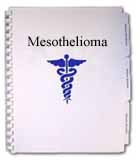Mesothelioma Symptoms and Diagnosis
Mesothelioma Symptoms
The most common symptoms of pleural
mesothelioma are difficulty in breathing, chest pain,
or both. Occasionally, a patient may not have mesothelioma symptoms at
diagnosis. Other less common symptoms include weight loss,
fever, night sweats, cough, and a general feeling of not being
well. Mesothelioma symptoms of peritoneal
mesothelioma may include swelling, pain due to accumulation
of fluid in the abdomen cavity, weight loss, and a mass in
the abdomen. Other mesothelioma symptoms of peritoneal mesothelioma may
include bowel obstruction, blood clotting abnormalities, anemia
(a lowered red blood cell count), and fever.
Mesothelioma Diagnosis
It can be difficult to diagnose mesothelioma
because many of the mesothelioma symptoms are similar to those of a number
of other conditions, including lung cancer and other types
of cancers. At the time of diagnosis, your doctor will first
do a physical examination and complete a medical history,
including asking about the possibility of prior exposure to
asbestos.
Although there is no early detection test for mesothelioma, there
are several tests that can be used to help in making the diagnosis
of mesothelioma, including a chest x-ray, a CT scan, or an MRI scan.
A chest x-ray yields an image of the lungs that will show many types
of abnormal changes. A CT scan (computed tomography) is a type of
x-ray, but it uses a computer rather than film to create detailed
images.
An MRI scan (magnetic resonance imaging) uses magnetism,
radio waves, and a computer but does not utilize radiation to create
a clear image. These tests help your doctor differentiate mesothelioma
from other lung tumors as well as determine where the tumor is and
its size.
Your doctor may need to remove a tissue sample from the tumor (a
biopsy) or draw fluid (aspirate) from it to confirm it to confirm
the diagnosis. This can be done in several ways.
The simplest way to obtain tissue samples involving making a small
incision and placing a flexible tube in the area of the tumor. This
is called a thoracoscopy if it is done in the chest area. A laparoscopy
is the same procedure, but done in the abdominal cavity. A tube
that is that is attached to a video camera is placed so that the
doctor can look inside the body. A tissue sample may be taken at
the same time. Sometimes, however, a more extensive surgical procedure
may be advisable. A thoracotomy can be done to open the chest to
take a tissue sample and, if feasible, to remove most or all of
the visible tumor. If this procedure is done in the abdominal cavity,
it is called a laparotomy.
At other times, a mediastinoscopy may be done in which a very small
incision is made just above the sternum (breast bone) and a tube
inserted just behind the breast bone. This lets the doctors look
at lymph nodes. This are small, bean-shaped structures that are
an important part of the body's immune system, and they contain
cells that help your body fight infection as well as cancer. This
test will give the doctor more information on the type of cancer
and whether it has spread to other areas. The tissue samples taken
in these procedures are analyzed by looking at them under a microscope
in order to determine whether the tumor is a mesothelioma or some
other type of cancer.
|

































